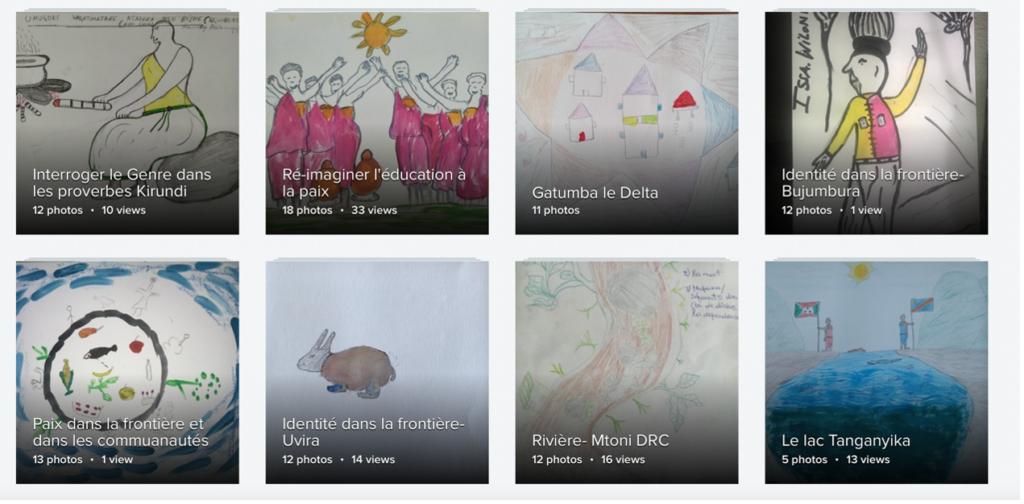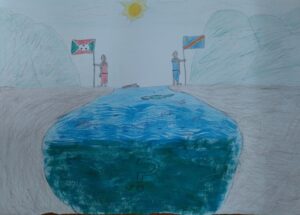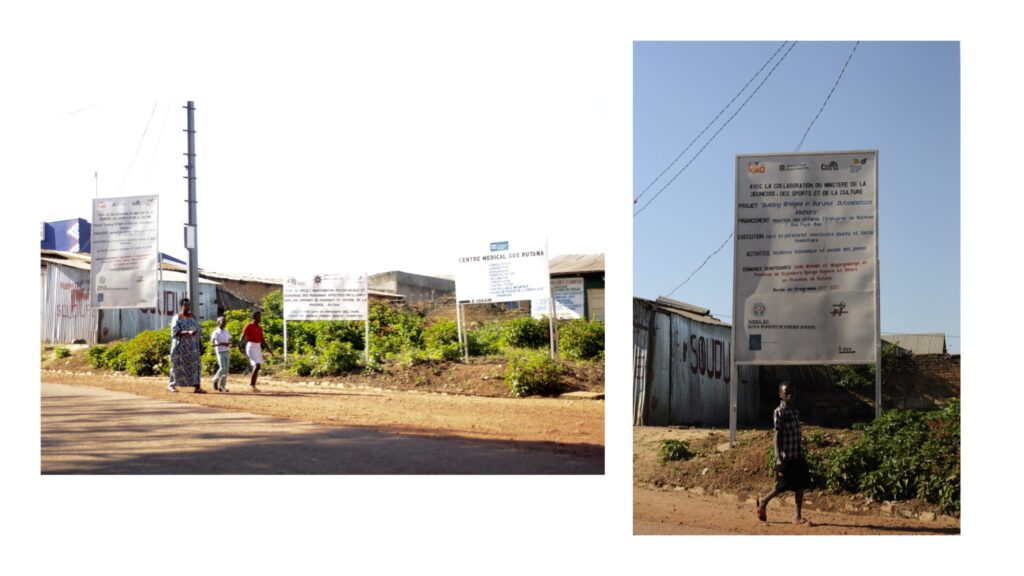This blog is based on several discussions on the interpretation of the first series of drawing workshops between Clément Basabose, Fabrice Djuma, Astrid Jamar, Christelle Balegamire Karuta and Jean-Paul Nizigiyimana.
Authors: Astrid Jamar, Christelle Balegamire Karuta, Jean-Paul Nizigiyimana
We are sitting at a table in the shade of Amahoro café, our usual café on the Avenue du 28 novembre in Gatoke, Bujumbura. The drawings on peace education and peace on the border are spread out on the table in front of us. We are rereading the texts written by the participants and accompanying each drawing. Many of the drawings and texts refer to dance, fire, song, family, drumming and dialogue. For the participants, these Burundian and Congolese traditions are essential for the transmission of knowledge and stories, as well as for socialisation that promotes self-understanding and social cohesion.

Les dessins et textes des deux ateliers sont disponibles sur Flickr
Still around this table, we find ourselves quickly in uncomfortable conversations. What is decolonial about these drawings and texts? Why might these representations of indigenous knowledge and models even reproduce a certain form of coloniality? Or, to borrow Sylvia Tamale’s (2020) definition, how might these representations be linked to the ideological system and “invisible power structures that maintain colonial relations of exploitation and domination long after direct colonialism has ended” that have infiltrated “the production of knowledge and the establishment of social orders”?
For me, Astrid, a researcher based in a European university and directing the project, I don’t see how these drawings and texts reflect decolonial issues. My questioning turned into frustration. Why put so much energy into a project that operates and reproduces the same coloniality as classic NGO peace projects? I, Jean-Paul, a Burundian researcher, think that these drawings are decolonial because they show the ways of making peace that pre-existed political and cultural colonisation. On the other hand, I also think that the messages accompanying these drawings reflect colonial visions. As far as I’m concerned, as Christelle, a Congolese researcher, my concerns focus on the feelings and motivation of the participants in relation to the coloniality that emerges from their drawings and texts. Do they also recognise this? All three of us noticed that particularly the texts written in French reproduced an NGO discourse – for example, by promoting social cohesion detached from the structural issues linked to insecurity and armed conflict.
Gradually, we tried to reformulate the discussions around questions to move the discussion forward: What is different about these visual and textual representations from what peace NGOs are already doing? How can we bring out a decolonial analysis in discussions where decolonial issues are not explicitly raised?
Over the course of May, we returned several times to the same discussion with two colleagues. For Fabrice, a Burundian-Congolese painter who has organised the project’s art workshops, everything to do with peace and violence starts with personal responsibility. For Clément, the Burundian focal point, local spaces for exchange and sharing, rooted in Burundian traditions, are essential if communities are to become healthier. We tried to see where everyone’s positions came from, to identify the tensions and nuances. We managed to identify several paradoxes:
On the one hand, these drawings and the texts and conversations that have emerged from them highlight the cultural richness of this border region and the central elements of Burundian and Congolese cosmologies that maintain social cohesion.
On the other hand, these drawings and discussions reproduce a certain form of idealisation of ‘local’ solutions to security, structural and global problems – while avoiding reflection and action on these same issues.
We read, discussed, re-read and re-discussed a text by Elisa Randazzo (2021) on the limits of rethinking peacebuilding through ‘local’ and ‘indigenous’ solutions. Randazzo explains that the growing interest in indigenous perspectives runs the risk of further marginalisation and appropriation of indigenous perspectives. This interest makes it possible to “rescue” the legitimacy of the practices and postulates of liberal peacebuilding through the back door, without calling these practices and postulates into question. We have considered the relevance of this analysis to the decolonial issues at stake in the Burundi-Congolese borderlands.

We work and/or live in a context marked by the ubiquity of this so-called liberal “peace industry”. An industry that deploys “a range of actors and often relies on multi-layered missions, from democratisation to economic restructuring, security sector reform and the establishment of transitional justice mechanisms”, but which “fail to provide lasting solutions to end (armed) conflicts and which formulate imposed and dogmatic solutions based on a linear understanding of cause and effect.” Since the 1990s, large UN missions and numerous multilateral and bilateral organisations and NGOs have worked for peace in Burundi and the DRC with colossal budgets. While armed conflicts are still ongoing in the region, the Congolese and Burundian populations and governments have increasingly taken a stand against these peace missions (e.g. Sengenya 2022).
The values promoted by customary models are now tools of “liberal peace” deployed by international organisations and NGOs. This idealisation of the “local” helps to legitimise these external interventions promoting peace in all spheres of Burundian and Congolese communities. To such an extent that this “peace industry” has somehow instrumentalised and infiltrated these ancestral models. Around a hundred NGOs and organisations involved in peace work operate in Bujumbura, Gatumba and Uvira – the border area with which we are working. A lot of people around us are involved in one way or another, as staff of these organisations, workshop leaders or facilitators, and/or participants in an action, the target audience of a discussion via radio broadcasts and announcements about peace promotion. In this environment, it is difficult to form one’s own opinion on the issue of peace without it being corrupted by NGOs visions – articulated around simplistic linear project visions.

Indeed, we observed interchangeable use of notions linked to social cohesion and well-being (the essence of the Kirundi word ‘Amahoro’ or Swahili word ‘Amani’) or peace as a synonym for the end of armed conflicts (in reference to the tools for resolving armed conflicts through examples such as peace agreements, peace missions and peace building) in this border area. This amalgam between notions rooted in indigenous cosmologies and Eurocentric concepts of peace is only present in areas affected by conflict. In Western societies, the notion of peace is mainly used to refer to war in the countries of the South. Does this conflation of different notions of peace in everyday use make it easier for the peace industry to exploit them? Certainly.
In conclusion, our debates around these drawings and discussions and the coloniality of peace encourage us to leave our comfort zones and our ‘expertise’ acquired through our academic careers and/or NGO experience. To break out of this coloniality, we feel it is important to encourage people to take account of this instrumentalisation of notions linked to social cohesion in Burundian and Congolese cosmologies, as well as the structural and material dimensions of armed conflicts. The exchanges, discussions, drawings, writing and poetry that emerged from the workshops and various meetings in this project are in themselves a re-imagining of peace interventions and peace education as such.
Reférences
- Campbell, Susanna, David Chandler, and Meera Sabaratnam. 2011. A Liberal Peace?: The Problems and Practices of Peacebuilding. Bloomsbury Publishing.
- Randazzo, Elisa. 2021. ‘The Local, the “Indigenous” and the Limits of Rethinking Peacebuilding’. Journal of Intervention and Statebuilding 15 (2): 141–60.
- Sengenya, Claude. 2022. ‘Why We’re Protesting against UN Peacekeepers in DR Congo “Who Will Come to Save the Congo? Only Us Young People.”’ The New Humnanitarian, 18 August 2022. https://www.thenewhumanitarian.org/news-feature/2022/08/18/DRC-MONUSCO-protests-peacekeeping.
- Tamale, Sylvia. 2020. Decolonization and Afro-Feminism. Journal of Contemporary African Studies.

